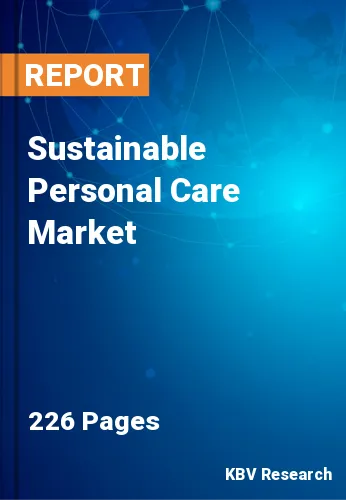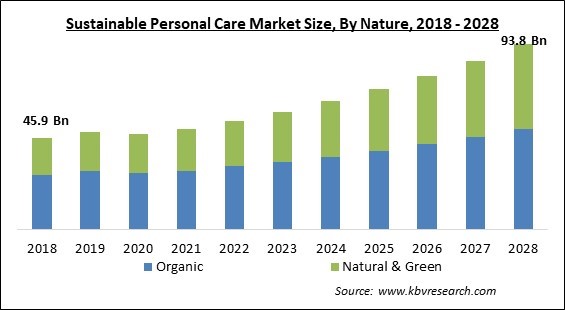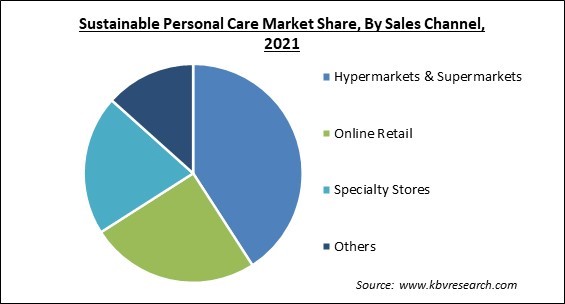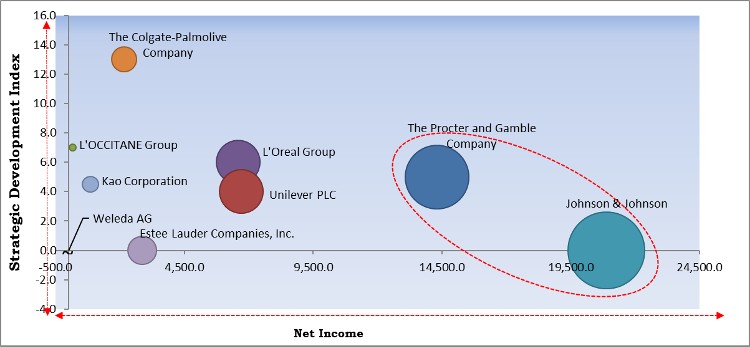
The Global Sustainable Personal Care Market size is expected to reach $93.8 billion by 2028, rising at a market growth of 9.4% CAGR during the forecast period.
Personal care and cosmetics are routinely utilized in large quantities all around the world. As a result, personal hygiene, as well as cosmetics products or chemicals, are continuously released into the environment in an unnoticed manner. As these bioactive are extremely persistent in the environment and may also bioaccumulate, they have an overall impact on the lives of living beings. Personal care and cosmetics refer to any product that is applied to the outside of the body, such as the skin, nails, lips, hair, and external genital organs, or oral hygiene, such as the teeth and mucous membrane of the oral cavity, in order to clean, protect from germs, prevent bad odor, change appearance, and maintain good health. Personal care and cosmetic items, unlike medicinal medications, can only be administered for external use.

As a result, they are more likely to infiltrate the environment in large amounts as a result of human activities, such as bathing or washing, causing more problems for ecological systems. Daily use personal care and cosmetic items include soaps, hair colors, nail paints, scents, emulsifiers, UV absorbers, preservatives, acrylates, and antioxidants. Some of these are harmful to one's health, and prolonged exposure to them can lead to cancer, endocrine disruption, allergies, mutation, and reproductive toxicity. Therefore, the preference of people all over the world is rapidly being shifted toward organic and sustainable personal care products. Sustainability has evolved from a novelty to a requirement in the personal care industry. Raw material sourcing, product compositions, manufacturing processes, distribution, packaging, and marketing, along with product end-of-life considerations, are all becoming more sustainable. The surge in client demand for ethical products is one of the main reasons behind this.
In recent years, the concept of sustainable personal care has become one of the most popular in the industry. It began as a modest movement centered on environmentally friendly companies and has grown into a rapidly expanding and dynamic personal care market in the modern era. There has been a drive for improvement in skincare, haircare, makeup, and scent as customers become more aware of the dangers of excess plastic and non-recyclable packaging, as well as substances that damage ecosystems and their personal health.
The COVID-19 pandemic affected the sustainable personal care market. The supply of sustainable personal care products was reduced. As a result, the demands of a significant number of customers remained unfulfilled. Furthermore, consumer focus has migrated to internet enterprises at an unprecedented rate as a result of the COVID-19 pandemic. As a result of these recent developments, market players are spending to provide their customers with a unique digital experience. COVID-19 introduced several new issues, the severity of which was determined by the portfolio as well as regional exposure. As a result, the sustainable personal care market is coping with a very different client and retail environment.
Cosmetics is one of the least regulated industries across the world. In reality, harmful compounds can be found in the ingredient lists of various beauty products, including toothpaste, shampoos, and bubble baths. According to some research, human bodies absorb up to 5 kilos of hazardous compounds each year from beauty products. Petrochemicals and parabens, which are used in traditional cosmetics to extend their shelf life, are among the most harmful ingredients. Parabens, according to several scientific research, cause the body to stop manufacturing estrogens and may be the cause of a variety of ailments, including cancer, a weakened immune system, and allergies.
One of the most prominent advantages of utilizing sustainable personal care products is that it contributes to a clean and better environment. The cosmetics industry's unsustainable practices have resulted in considerable amounts of deforestation, pollution, and water scarcity. Using sustainable personal care instead of harmful cosmetics in daily life can majorly help in minimizing the amount of pollution and trash produced each year. This results in a cleaner as well as a healthier environment for people to live in.
One of the drawbacks of natural cosmetics is that they do not always include the exact ingredients that are required for a particular skin type. This could be because the manufacturers are unable to obtain the compounds they require for the manufacturing of any specific sustainable personal care product, or because they do not include those ingredients in their product. Many companies, for example, do not employ parabens in their products because they have been proven to be hazardous even at little levels. Organic cosmetics makers need to conduct more studies to identify the ingredients that would provide the best outcomes for their customers.
Based on Nature, the market is segmented into Organic and Natural & Green. In 2021, the organic segment acquired the largest revenue share of the sustainable personal care market. The rapidly increasing growth of this segment is majorly owing to the rising consumer demand for pesticide-free, clean-label, and natural products. Organic sustainable personal care products are created from plant materials grown in soil free of pesticides, herbicides, fungicides, and synthetic fertilizers, and contain no GMOs.

Based on Sales Channel, the market is segmented into Hypermarkets & Supermarkets, Online Retail, Specialty Stores, and Others. In 2021, the online retail segment acquired significant revenue share of the sustainable personal care market. An increase in the use of e-commerce portals in emerging regions, as well as an increase in the number of deals or discounts made available by these E-commerce platforms, is attracting end-users, such as home consumers and institutions, to buy sustainable personal care through these platforms. Moreover, e-commerce platforms have increased client reach, making them a substantial source of revenue for many enterprises.
Based on Type, the market is segmented into Skin Care, Hair Care, Oral Care, Hygiene Products, and Others. In 2021, the skin care segment registered the largest revenue share of the sustainable personal care market. The increasing growth of this segment is attributed to the increasing focus of people all over the world on enhancing the quality of their skin. Human behavior is influenced by skincare products. Everyone strives to have healthy, bright skin in order to appear appealing. Serums, body lotions, moisturizers, exfoliators, and eye creams are examples of skincare products that aid in the maintenance of healthy and bright skin. Furthermore, sustainable skincare products are created with natural and organic components that have minimal or no negative effects on human skin or the environment, which is likely to drive market growth over the forecast period.
| Report Attribute | Details |
|---|---|
| Market size value in 2021 | USD 50.6 Billion |
| Market size forecast in 2028 | USD 93.8 Billion |
| Base Year | 2021 |
| Historical Period | 2018 to 2020 |
| Forecast Period | 2022 to 2028 |
| Revenue Growth Rate | CAGR of 9.4% from 2022 to 2028 |
| Number of Pages | 226 |
| Number of Tables | 374 |
| Report coverage | Market Trends, Revenue Estimation and Forecast, Segmentation Analysis, Regional and Country Breakdown, Competitive Landscape, Companies Strategic Developments, Company Profiling |
| Segments covered | Nature, Type, Sales Channel, Region |
| Country scope | US, Canada, Mexico, Germany, UK, France, Russia, Spain, Italy, China, Japan, India, South Korea, Singapore, Malaysia, Brazil, Argentina, UAE, Saudi Arabia, South Africa, Nigeria |
| Growth Drivers |
|
| Restraints |
|
Based on Regions, the market is segmented into North America, Europe, Asia Pacific, and Latin America, Middle East & Africa. In 2021, North America accounted for the highest revenue share of the sustainable personal care market. This is highly due to the region's vast awareness of sustainable ingredients and products. The demand for environmentally friendly personal care is growing in the United States and Canada, boosting the regional market growth. Moreover, the prevalence of a significant number of major market players operating in the sustainable personal care market is also driving the growth of the regional market.
Free Valuable Insights: Global Sustainable Personal Care Market size to reach USD 93.8 Billion by 2028

The major strategies followed by the market participants are Acquisitions. Based on the Analysis presented in the Cardinal matrix; Johnson & Johnson, The Procter and Gamble Company are the forerunners in the Sustainable Personal Care Market. Companies such as L'Oreal Group, Unilever PLC and The Colgate-Palmolive Company are some of the key innovators in the Market.
The market research report covers the analysis of key stake holders of the market. Key companies profiled in the report include L'Oreal Group, Johnson & Johnson, The Procter and Gamble Company, Unilever PLC, Kao Corporation, The Colgate-Palmolive Company, Estee Lauder Companies, Inc., Coty, Inc., L'OCCITANE Group, and Weleda AG.
By Nature
By Sales Channel
By Type
By Geography
The sustainable personal care market size is projected to reach USD 93.8 billion by 2028.
Good for health and skin nourishment are driving the market in coming years, however, Lack of exact particular substances limited the growth of the market.
L'Oreal Group, Johnson & Johnson, The Procter and Gamble Company, Unilever PLC, Kao Corporation, The Colgate-Palmolive Company, Estee Lauder Companies, Inc., Coty, Inc., L'OCCITANE Group, and Weleda AG.
The expected CAGR of the sustainable personal care market is 9.4% from 2022 to 2028.
The Hypermarkets & Supermarkets segment acquired maximum revenue share in the Global Sustainable Personal Care Market by Sales Channel in 2021; thereby, achieving a market value of $36.7 billion by 2028.
The North America market dominated the Global Sustainable Personal Care Market by Region in 2021, and would continue to be a dominant market till 2028; thereby, achieving a market value of $32.2 billion by 2028.
Our team of dedicated experts can provide you with attractive expansion opportunities for your business.
